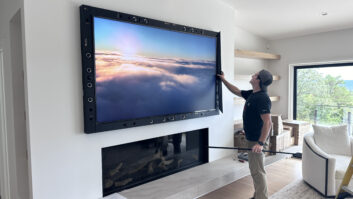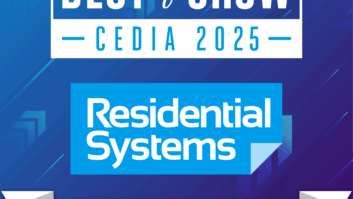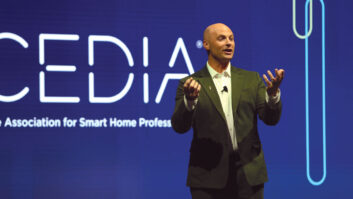Recently, while I was researching the growing sales of analog turntables, vinyl records, and analog two-channel systems, an integrator told me that he had to scramble when he realized he was not capitalizing on this “analog renaissance.” This integrator did not have a high-performance two-channel music system with a turntable on display in his showroom, even though his facility was otherwise well appointed with solutions for home theater, distributed audio, lighting, and motorized shades. How could he have missed this increasingly obvious trend?
“Don’t be so surprised,” said one manufacturer I spoke with who requested anonymity. “Integrators today have no idea on how to connect with customers and really ‘sell.’”
Really? Integrators don’t know how to sell?




The “showroom” that the Echo Systems sales team walks the client through is literally a $2.5 million home with every room outfitted with absolutely the best technology available.
At the beginning of the custom installation industry, clients in the process of building new homes reached out to their local custom installation specialist to assist them in selecting and installing technology throughout their homes. The custom installer would go over plans, meet with the clients, and ask a lot of questions about their preferences. A technology systems plan would be drawn up, pitched to the client for approval, and then installed during the construction of the home. But has this process changed?
Our disgruntled manufacturer seemed to suggest so, as he went on a bit of a rant. Integrators, he said, simply sell the same products over and over again. Custom installation, he claims, is a misnomer. “There’s nothing custom about it. It’s more like the cookie cutter installation industry,” he said.
The typical sales process, he went on, is that a client comes to the integrator, tells them they’re building a new home and they want technology in it. “What should we get?” the manufacturer said the client asks the integrator. “And the integrator sells them the same system they sell all of their clients.”
If this manufacturer is correct, then integrators are not customizing systems for their clients. Rather, they are convincing clients to take what the integrator wants to install.
What Happened to Qualifying the Client?
Sales experts will tell you that a critical step in the sales process is “qualifying” the prospect. Qualifying involves asking open-ended questions to elicit information to determine whether the prospective client is well suited for the types of goods and services that your organization offers. Those who adhere to a consulting-style sales process often refer to this step as the “assessment” phase…or needs assessment. In this phase, the integrator seeks to determine the client’s project scope, their preferred lifestyle, their “needs,” and their “wants” from their home technology solution. Ideally, it is in this assessment phase where the client’s desire for either a theater or a music listening system is accurately determined.
Like some kind of two-headed monster, my investigation into the emergence of growing analog systems sales led to the discovery that there are two trends affecting how technology is sold to clients by integrators today. One issue is the challenge of selling high-performance systems in an integration industry with changing consumer-shopping preferences. The second is the trend of less customization in system design by today’s integrators.
Do Integrators Know How to Sell?
When asked if he related to the manufacturer’s comment that integrators don’t know how to sell, CEDIA’s senior director of emerging technologies Dave Pedigo said that he definitely understood that sentiment.
“In our research we have found that our members identify that [sales skills] as a weakness,” he recalled. “I haven’t [personally] come across that, but I’ve heard that from the manufacturing community. So I do think that there’s a gap there and that folks could learn from it.”
Pedigo, who once had a prominent role in the training programs that CEDIA offers its members, noted that the organization conducts member training that is broken down into two primary tracks.
“We basically break our education down into two parts: the technical working groups and our business working groups,” Pedigo said. “Just over half of our volunteers that we have on the education side help us identify, develop and deliver business training…and a part of that business training is sales and marketing.”

Dennis Jacques of Maverick Integration, a leading New England integrator, said that most integrators have the wrong focus when approaching a prospective client. They start meetings by pitching their control, automation, or video lines, which for the most part generate lower gross profit dollars as compared with high-performance electronics.


Dennis Jaques, of Maverick Integration, has a clearly defined process designed to drive sales of high-performance and results. It starts in what they call their “Digital Playground.”
“I worked at a company that went out of business in 1999. Then I started my own company in 2000 and decided that I’m not going to go out of business,” Jaques energetically explained. “So in 2008, I decide to go upscale selling–not downscale. There’s plenty of people going down, less people going up, so I’m going to have less competition going up than if I go down.”
Jacques said that a financial yardstick called Gross Profit Dollars Per Man Day (GPD/MD) informs all of his management decisions. This financial calculation, which Jacques said is easy enough for anyone to use, factors in the impact of both the product and labor gross profit dollars. It’s far more effective, he said, than just simple product margin.
“I figured out that if you want to drive that number, there are only two components: how many tickets you want to do and the amount of the average ticket.”
Looking at his business this way, Jaques quickly realized that selling high-performance audio not only helped differentiate him from his competitors, but raised his average ticket value and generated a much higher GPD/MD.
One way that Maverick delivers on the sales of high performance audio is by cross training his entire team.
“Some of my guys are really good at commercial work, some are really good at two-channel, some are really good at theaters, and I know lighting control really well,” Jaques explained.
The Generational Issue
Home Technology Specialists of America (HTSA) executive director Jon Robbins said that his organization, a buying group made up largely of hybrid retailers (retail/integrator) and custom integrators, is well aware of this issue and see it in part as a generational issue.
“I don’t disagree with [the manufacturer who said integrators can’t sell], and that’s the reason we’re spending a lot of time with our members on education,” he said. “The whole reason for doing the education is because yes, that’s the trend. The trend has been that [integrators] are technologists [not salespeople]. Now we’ve got to take what we know about audio and how to present it and how to best demo it, to help them sell more effectively.”
Robbins attributes the issue to a general lack of awareness of high-performance AV among Millennials and even Gen X clients.
“A lot of the clients that we are talking to now–if we really look at it specifically, Gen Xers and Millennials don’t even know that really good audio exists,” he added. “The extent of music being distributed to them is what they hear in their car or what they get through headphones…or just background music. They don’t have an understanding of higher-end music reproduction.”
Robbins said that through proprietary education programs, HTSA has had success in not only increasing their members’ sales of high-performance audio, but driving the segment for the industry as a whole.
“The hybrid dealers will do a pretty compelling job of presenting [high-performance audio] to people. But the CI guys, for the most part, won’t even present the difference in audio to people,” he argued. “One of the things we learned from our Sell More Audio Masterclass training earlier this year is that it’s all in the art of the demo, and HTSA spends a lot of time and a lot of money refining our members’ ability to present the most compelling demos out there.”
Is There an Echo in Here?
Doug Dushan at Echo Systems, an Omaha, NE-based integrator, said that the manufacturer who ranted about integrators poor sales practices was definitely on to something.
“I think he’s right about what I see from competitors on a daily basis– an impersonal list of products that really haven’t delved into the clients themselves,” Dushan said.
In fact, Echo sees it so frequently with clients who have been shopping around, that he and his team have to take steps to counter it.
“I think, unfortunately, that’s a really common trend in our industry because there is demand for technology, because clients don’t know what questions to ask, and because salespeople are not asking questions. [Instead] they’re just simply saying, ‘Sure, well here’s your system.’ How can you do that? You don’t even know anything about these people.
“I often have to kind of retrain clients in some sense,” Dushan explained. “I ask them, ‘Do you really know what this list of products means to you?’”
Integrators Sell Solutions, Not Performance
Azione Unlimited, another dealer buying group made up of predominantly custom integrators, sees changing market trends as affecting the sales process. Azione president Richard Glikes felt that to better understand the situation, it was necessary to understand the role of the integrators.
“I think that integrators are not comfortable with two-channel. For most of the young guys, it’s all about control,” Glikes said. “They’ve become shading and lighting companies, more than AV companies. And they’ve forgotten about the ‘A’ in AV–’A’ to them is distributed audio. That’s the way they think.”
Glikes contends that selling high-performance audio or AV systems is a different business than the one in which most integrators participate.
“This gets back to selling performance. Integrators, typically, don’t sell performance; they sell solutions. That’s really the crux of the matter,” Glikes said. “And you can’t have one pair of speakers and one turntable and one two-channel amp and think you’re in the two-channel business. It doesn’t work like that. You do have to show a selection, and that’s not the integrator’s game. An integrator is just-in-time inventory, nothing on display, heavy on engineering. And typically a salesperson may be a project manager. They may be the same person.”
But isn’t it a shortcoming that integrators have project managers versus salespeople?
“I think what happens with good integrators is that they have good builders who basically hand them clients on a platter,” Glikes answered. “And then it’s as much engineering as it is salesmanship. And it’s also reputation and being able to work with the builder. If the builder says ‘this wall’s going up on Tuesday, you better have your wires in’–they’re able to do that. Now that doesn’t require any selling at all.”
Properly Selling High Performance Systems
Maverick Integration has a clearly defined process designed to drive sales of high-performance and high GPD/MD results. It starts in what they call their “Digital Playground.”
“I sell because we try to get [clients] into the office,” Jaques said, referring to the showroom in their facility that they refer to as their Digital Playground. “[There] I have an 18-foot screen in the theater…with a big honking audio system…and a big honking two-channel system…and a CinemaFrame…a Bang & Olufsen system with acoustical fabric…and Hartmann & Forbes shades…Lutron shades…Lutron Finiré light fixtures…trimless lights …trimless speakers…and cork wallpaper. All of these things that we put in and install are things that none of my competitors do. And you just do demos for them. I’ll say, ‘Let me show you something’ and then get them excited about stuff. If you get them excited about it, there’s your margin–which grows your GPD/MD. Just show people.”
Although in a completely different part of the country, Echo Systems takes a very similar approach. First and foremost, you can’t just start firing questions at clients about what they want, Dushan said.
“If you start asking questions as soon as you meet a client, they’re basing [their answers] on potentially misinformation or inaccurate information. They don’t know what’s available,” he explained. “So we start by giving them an overall showroom tour and keep it very topical. I talk about aesthetic concepts. I talk about quality concepts. We talk about the direction of things–of what’s possible.”
The “showroom” that the Echo Systems sales team walks the client through is literally a $2.5 million home with every room outfitted with absolutely the best technology available.
“You walk room to room–there are no vignettes–I mean, it’s a home,” Dushan said. “There is a full custom kitchen, full formal dining room, a great room with Steinway speakers that motorize out of the ceiling. There is technology throughout the house.”
The walkthrough is meant to show concepts more than specific products and, to leave a lasting impression, the tour concludes in the home’s million-dollar home theater. Dushan says that, without fail, clients’ “jaws hit the floor.”
Only then does the Echo Systems consultant sit down with the client to discuss their desires and preferences. Now the client has a better appreciation of just what’s possible. Like Maverick, Dushan said this tour is a key factor in differentiating Echo Systems from their competitors.
Still, Dushan said for the client, it’s all about just one thing. “Most of my clients are really looking for an organization they can trust,” he concluded. “[An organization] that is going to hear their needs and execute upon their needs.”
Ted Green publishes a widely read weekly CE business blog at Stata-gee.com, the online home of The Stratecon Group, his marketing and strategy agency for the tech industry.







